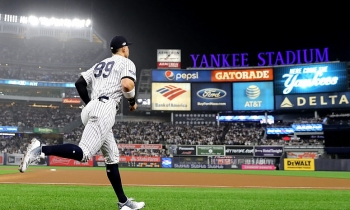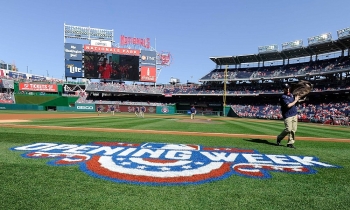2022 MLB: New Rules and Details of Agreement on New CBA
 |
| What's next for baseball as MLBPA, owners reach agreement |
New MLB Rules for the 2022 Season
The franchise is no longer debating, but baseball rules are changing.
After a nail-biting 99-day stalemate, the MLB and the MLBPA have come to a tentative agreement, allowing baseball to begin its 2022 season – and it’ll look slightly different than it did in 2021.
Each team will embark on their regular 162-game journey for the 2022 season, beginning on April 7.
Players will take the field in a few short days with spring training starting this Sunday, March 13 and free agency kicking off as soon as ratification occurs tonight.
While normalcy has returned to the organization and millions of aching fans have finally been ensured their baseball, this season won’t be the same as the last. There are quite a few changes in the rulebook for the 2022 MLB season.
What new rules are reportedly included in the collective bargaining agreement?
Talks were majorly centered around labor and core economics, including the salaries of players. However, the agreement covers all aspects of the game.
It was decided that there would be a 45-day window for MLB to apply rule changes. Here are some other elements implemented within the CBA:
General game play rules
- Pitch clocks will be used.
- There will be a ban on defensive shifts.
- The National League will adopt the designated hitter.
- There will be larger bases in the 2023 season.
Postseason rules
- The postseason will expand to 12 teams.
- There will be no man on second base to start extra innings.
Draft rules
- A draft lottery will be implemented to discourage tanking.
- In order to prohibit service-time manipulation, draft picks will be induced.
Other changes implemented:
- For the first time, player uniforms will feature advertising, including patches on jerseys and decals on batting helmets.
- The number of times a player can be optioned to the minor leagues in one season will be limited.
- The 2023 schedule will be more balanced as teams will play at least one series against every opponent in both leagues.
Establish COVID protocolsThis should be fairly easy and straightforward. MLB and the MLBPA can reup last year's COVID protocols, make any necessary tweaks, and call it a day. The NBA, NFL, and NHL stopped testing vaccinated players unless they show symptoms in recent weeks (the NFL and NHL put those policies in place in the middle of their seasons) and we would expect MLB to adopt a similar policy. Otherwise the COVID policy figures to look a lot like last year's. The two sides just have to shake on it. |
Why are changes being placed for the 2022 MLB season and beyond?
Over the past four years, player salaries have dropped despite the growth of revenues. The franchise value has risen – almost quadrupled – and therefore players decided to speak out.
Besides economics, other aspects of the game have been questioned in the last few seasons. Bans on shifts have been pondered in order to keep the defense more honest. In the last five years, players have been utilizing this defensive shift tactic, and many people are arguing that original baseball rules permit players to shift anywhere they want. Then again, the shift prohibits line drives and sharp ground balls, so in order to increase balls in play, hits and baserunners, a ban on defensive shifts was proposed.
Additionally, the pitch clock was proposed to improve the pace of play. It would discourage the pitcher from stepping off the rubber and shorten at-bats.
And finally, larger bases would make base-stealing easier and more common. The stealing of a base has become less and less frequent because of replay rules so increasing the size of the base would at least make the act more compelling.
Why do rules change in professional sports?
The primary reason for rule changes in sports is to improve the actual play of the sport, helping it grow and evolve alongside society.
Rule changes can increase the attraction of the sport to fans. From a marketing perspective, rule changes can play a role in popularizing a sports brand by increasing consumer engagement. To serve the attraction of viewers, rule changes are intended to speed up the pace of the game so fans pay attention and are instantly gratified. Similarly, rule changes allow for more points to be scored so fans can celebrate their teams.
Other purposes of rule changes include safety and integrity through fair play. Sports are meant to be competitive and exciting, but above it all, safe and ethical.
Can we expect rule changes in the future?
Rule changes are part of a sports’ history. Sports are constantly evolving and part of that evolution is growing alongside the society we live in. As society advanced, so did sports – whether that be in the technological, physiological or ethical sense.
When baseball was first played in New Jersey’s Elysian Fields in 1846, do you think defensive shifts were questioned? In fact, they might not even have occurred. Designated hitters weren’t granted until the 1970s, and the spitball was banned after Cleveland shortstop Ray Chapman died following being struck in the head by one in 1920.
In essence, rules have and will always change because society will always be developing in some way, shape or form. The longer sports are played, the more professionals discover aspects of the game that can be altered or improved. Since professional sports are composed of millions of different participants, including athletes, coaches, committees, organizations, and franchise owners, we will never stop seeing sports evolve. That you can count on.
The Details of the Agreement on New CBA
MLB owners and players reach agreement on a new CBA
MLB owners threw in a couple of last minute demands for the players to drop their pending grievances against four teams for failure to spend revenue sharing dollars on improving their teams, and for failure to schedule as many games as possible in 2020. We’ll see how that played out as details emerge.
Reports are that the regular season will begin on April 7, with spring exhibition games starting on March 17 or 18. The transaction freeze will be lifted tonight.
Competitive Balance Tax
- The collective bargaining tax thresholds, which have been the hardest part of negotiations in this round, will be set at $230 million, with three additional tiers at $20 million increments. ($230M, $250M, $270M and $290M in 2022)
- The lowest threshold will be $230, $233M, $237M, $241M, $244M million over the five years of the deal
- Tax rates at the tiers will be the same as the previous CBA according to last reports, except for the new highest tier
- No report on any additional penalties, which were the topic of discussions
Minimum Salary- pre Arbitration Bonus Pool
- The minimum salary will increase from $570,500 to $700,000 in 2022, and will increase $20,000 per season to $780,000 over the five year term of the agreement.
- A new pre- arbitration bonus pool of $50 million will be drawn from the central revenue fund to pay the games top young players who are not yet eligible for arbitration. The amount will remain flat over five years.
- The pool will count $1.66 million per club for CBT payroll purposes.
Expanded Playoffs, Universal DH
- Playoffs will expand to 12 teams, starting in 2022.
- The two division winning teams with the best records in each league will have a first round bye. The third division winner and the highest wild card team will host a first round three game series- all games at home. This will net about $85 million from ESPN plus MLB’s portion of gate receipts.
- The designated hitter will be used universally in both leagues starting in 2022
Options, Draft Lottery
- Players can be optioned to the minor leagues a maximum of five times during one season
- The top six selections in the amateur draft will be chosen by a lottery among all non playoff teams
- Small market teams who received a lottery pick in two straight years could select no higher than 10th in the next year
- Large market teams who received a lottery pick could draft no higher than 10th in the second year
Service Time
- The top two players in rookie of the year voting will receive a full year of service time extra
- A team that has a rookie finish high in the voting can get up to three bonus draft picks if the player was on their opening day roster
Free agent compensation
- Teams will not pay compensation for signing free agent players- formerly subject to a qualifying offer, conditional upon the parties agreeing to terms on an international draft by July 25, 2022.
- Teams may receive a draft pick for losing a free agent player in some circumstances. Details on this point are scarce.
International Draft
- A 20 round International draft explained here at MLB.com will be implemented if the parties agree to terms by July 25, 2022. MLB insisted on this in exchange for eliminating free agent compensation, and it was a contentious sticking point until the end. Only by making that its own separate negotiation was the deal finally moved along to completion.
Playing Rules
- MLB may use a pitch clock starting in 2023
- There will be larger bases and restrictions on defensive shifts, also in 2023
- MLB may implement any rule changes without players’ approval within 45 days of the end of each season, to apply in the next playing season.
- Players will wear advertising patches on uniforms and helmets, estimated to bring in $6-8 million per year, per team
Grievances
- MLB demanded in their last proposal that the union drop grievances related to four teams failing to spend revenue sharing dollars to improve their teams on the field and a $500 million grievance related to MLB’s failure to schedule as many games as possible in 2020
Ghostbusters
It was reported that the players offered a 14 team playoff format, but only if it included a “ghost win” for the higher seeded team in a five game series, and the owners rejected that idea, thankfully. But if one of the rules that Manfred seeks to bring back involves ghost runners in extra innings, all will be lost.
You do the math
The minimum salary increase represents a pay hike of 22.7 percent for pre arbitration players, who make up the great majority of the MLBPA membership, most of whom will never see arbitration, let alone free agency. The bonus pool gives the best young stars a performance based bonus before reaching arbitration. That whole package- minimum salary and pre arbitration bonus will cost teams an average of under $3 million each.
Scheduling issues
Details on how the 162 game schedule will be reworked have yet to be announced, but we can expect at least the first two series, which were previously canceled, will have to be rescheduled. ,
The Detroit Tigers may have to add a late season west coast swing to make up canceled games in April.
 MLB Schedules - Full 162 Calendar of Games 2022 MLB Schedules - Full 162 Calendar of Games 2022 Find out the full schedules for the Major League Baseball (MLB) - all calendar of games in 2022. The full 162 game schedule will be ... |
 MLB Games Weekend: TV schedule for Opening Day baseball on ESPN, Fox, MLB Network MLB Games Weekend: TV schedule for Opening Day baseball on ESPN, Fox, MLB Network MLB is back with a full serving of baseball after the 60-game sprint in 2020, and it’s getting underway for everyone quick: All 30 teams ... |























